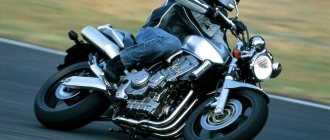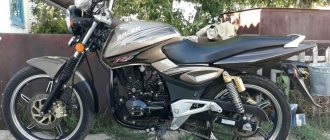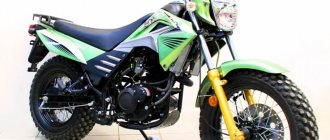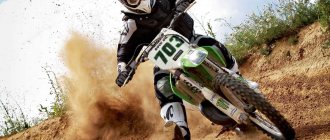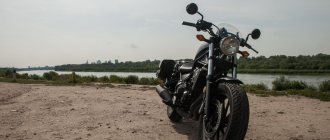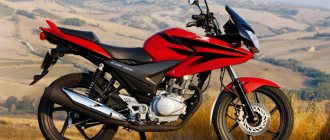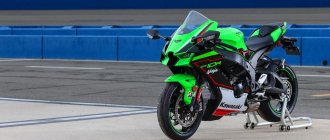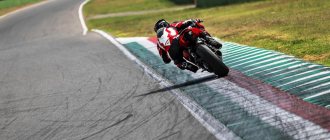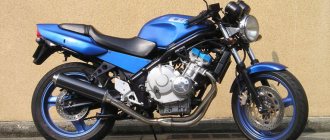- motorcycle model, Honda brand
The Honda CBF 500 naked model appeared in 2004 as a successor to the Honda CB 500 model, which, due to the update of environmental standards to Euro 2, could no longer be sold on the European market. Simultaneously with the Honda CBF500, the 4-cylinder model Honda CBF 600 appeared, which gained much more popularity, finally displacing the CBF500 by 2008. In addition, on January 1, 2008, new Euro 3 environmental standards came into force, which the CBF500 did not meet. Thus, the Honda CBF 500 model was produced for only 2 years, in 2004 and 2006, officially sold until 2008.
Unlike its predecessor (Honda CB500), the new Honda CBF500 model has received a number of technical and visual changes:
Appearance. The model gets a more modern design, a dashboard with a digital odometer and standard wheel sizes (120 and 160 mm wide at the front and rear, respectively). Frame. The main difference from its predecessor is the use of the engine as a load-bearing element. Brake system. The main thing here is the availability of versions with a combined braking system + ABS. Visually it is distinguished by a 3-piston front caliper in gold color and the presence of the letter A in the name - Honda CBF500A. Pendants. The model receives a new front fork with a 41 mm diameter of stays and a central monoshock absorber (instead of a double shock absorber on the sides), which has a 7-step preload adjustment. Fuel tank. Maximum capacity increased from 18 to 19 liters. In terms of engine and gearbox, the new Honda CBF500 model is practically no different from the old Honda CB500. Also notable is the fact that the CBF500 was only available in one classic version, while a semi-faired version was never offered.
The main competitors of the Honda CBF 500 in the class:
Kawasaki ER-5
Suzuki GS 500
Suzuki SV 400
Bike features
Here are the main features of the model:
- one brake disc each at the rear and front, the latter is a minus;
- a typical appearance for the class without any design bells and whistles;
- comfortable fit compared to many other bikes.
The car as a whole is well suited for driving in the city and on country roads, but the lack of a second brake disc at the front is a clear omission on Honda's part. However, if you purchase the version with ABS, the problem will not be so serious.
Brief history of the model
2004 - start of production and sales of Honda CBF500. Model: Honda CBF500, Honda CBF500A (Europe). Frame number: ZDCPC39A04F4F000001 - ZDCPC39A04F4F099999, ZDCPC39B04F4F000001 - ZDCPC39B04F4F099999, ZDCPC39C04F4F000001 - ZDCPC39C04F4F099999, ZDCPC39D04F4F 000001 - ZDCPC39D04F4F099999. Model code: CBF5004, CBF500A4.
2005 - model not produced. 2006 - no significant changes. Model: Honda CBF500, Honda CBF500A (Europe). Frame number: ZDCPC39A06F6F030001 - ZDCPC39A06F6F999999, ZDCPC39B06F6F030001 - ZDCPC39B06F6F999999, ZDCPC39C06F6F030001 - ZDCPC39C06F6F999999, ZDCPC39D06F6F 030001 - ZDCPC39D06F6F999999. Model code: CBF5004, CBF500A4.
2007 is the last year of sales of the model.
Engine
The Honda CBF 500 does not shine with either speed or acceleration: the maximum value to which it can accelerate is 179 km/h, while it will take 4.3 seconds to reach a hundred. The engine here is in-line, four-stroke and two-cylinder. Effective volume 499 cm³.
The maximum torque is 45 Nm, while the power at its maximum will be 57 hp. The unit is cooled using liquid. The engine has good performance, but there is nothing outstanding about it.
Dimensions and weight
The model reaches 2159 mm in length, 768 mm in width, and 1108 mm in height. The CBF 500 has a wheelbase of 1480 mm and a seat height of 770 mm. The motorcycle weighs 190 kg, and its tank volume is 19 liters. Taking into account the approximate average gasoline consumption of 5 liters per hundred kilometers, this is quite enough.
Chassis and brakes
The frame is made of steel, and its type is spatial. The wheels are alloy, the steering wheel is typical. The exterior corresponds to an ordinary modern road motorcycle, which does not pretend to be original in design.
The suspension at the rear is a progressive monoshock, while at the front it is a 41mm telescopic fork. The rear brake is a 240 mm disc along with a single-piston caliper, and the front also uses only one disc, but 296 mm along with a two-piston caliper. ABS may be available.
The first attempt to ride a powerful, handsome motorcycle ends in failure for many. If you smoothly release the clutch and then “unscrew” the throttle, the motorcycle will begin to accelerate sharply, and the unfortunate rider will have no choice but to clutch the steering wheel with his hands. Naturally, the “gas” is turned up instinctively and that’s it, a newbie can’t be caught... This would be the time for a person to calm down, relax his hands, and let off the gas. But the motorcycle no longer does. He doesn’t know that he’s a beginner, and he can’t know, the motorcycle has no mind, it only has character. The speed increases sharply, cheerfully sending the entire herd of horses into a gallop. The motorcycle quickly rises onto its rear wheel and... turns over! Everything happened in a maximum of 2-3 seconds. But all of the above may not happen if you try yourself on the Honda CBF 600 ABS that appeared this season.
When two new versions of the CBF 600 ABS model fell into the hands of Moto Drive testers, it was discovered that formally they differ from each other only in the presence or absence of a front fairing and the shape of the headlight. The design of the motorcycle did not present any avant-garde. The version without a fairing, with a round headlight and an inflated tank is cute, but not radical, a familiar modern “classic”. The average technical solutions of designers are quite justified - it would be risky to use untested stylistic solutions in the most popular model. What if the new design is not accepted by the majority of buyers, then everything is a failure. And its closest competitor, Suzuki SV650, is already quite popular. According to company representatives, the new CBF 600 ABS is designed from scratch. It has nothing to do with the Hornet family. The goal was to make an inexpensive, but comfortable and easy-to-ride motorcycle, and also as safe as possible. Looking ahead, let's say that all points of the task have been completed! Honda has created a new model that continues the lineage of the super popular family of “classics” of the SV series (the latest representatives of this glorious family are the SV 600 and 900 Hornet).
But let's return to the subject of the test. The presence of a large front fairing on the CBF 600 model with the “S” index makes the motorcycle not only more convenient to use, but also changes its overall perception. The fairing smoothly transitions into the tank. The latter seems wider due to the wide decorative overlays, but its capacity has not changed at all. The beauty of this or that modification depends solely on the preferences of the future owner, and it was not possible to come to a unanimous decision on how beautiful this or that version looks. For me personally, the CBF 600 with the round headlight looks more muscular and maintains the purity of the classic styling. But the modification with a windshield also has its admirers. By the way, the glass is adjustable; this attribute is borrowed from expensive touring motorcycles and I personally have not yet seen on middle-class models. I was driving and looking for the window adjustment button. Have not found. I had to call the dealer and ask how the glass was adjusted. It turns out that I wanted both honey and a spoon - if there is an adjustment, then “electro”. In the Moto World salon they cooled me down: the glass is adjusted manually and keys are needed to carry out this process. Caring for the comfort of the driver and passenger, but without sybaritism. By the way, it’s impossible not to describe the driver’s workplace... The seat, which from a distance looks like a two-seater and one-piece seat, is actually separate and has height adjustment for the driver’s side (adjustment range 3 cm). A key is again required for adjustment... We unscrew it, move the mounting bracket to the next position, tighten it, and sit down. Not very fast (not an electric drive with a five-position memory), but once you adjust it to your liking, you can forget about the adjustment. But it's cheap. In addition to the seat, you can also adjust the steering wheel to suit you. These two (rather rare) “features” make CBF a real leader in terms of ease of fit for people of different body types. But that's not all! Massive weights are screwed to the bottom of the driver's footrests to dampen engine vibrations. Passenger footrests are attached to the frame through rubber elements, which is also designed to dampen vibrations. Although it is not clear why these delights are needed, because the in-line “four” is well balanced. The design of the steel frame clearly follows the design of the Hornet model. Needless to say, the frame on both modifications of the CBF 600 ABS is absolutely identical. The pendants are as simple as possible. There is a non-adjustable fork at the front and a monoshock absorber at the rear with adjustable spring preload. There is no intermediate link system in the rear suspension; the shock absorber is attached directly to the pendulum. The braking system consists of two front discs and calipers from Honda's favorite supplier, Nissin. At the rear there is a single disc with a floating caliper. There would be nothing particularly tasty if this combination were not “seasoned” with an electronic anti-lock braking system. For this price range and class, this is an extraordinary solution. ABS, as a basic equipment, has not yet been seen on motorcycles of this class.
The last year has shown that it is becoming the norm for manufacturers to install power units from the previous generation of sportbikes on regular road models (classics). History repeats itself - we have already seen the CBF 600 ABS engine on the latest carburetor model CBR 600 F. In the original it had 110 hp, but for the CBF it was radically retuned. Changes affected camshafts, ignition, carburetors. As a result, the number of “horses” decreased to 70. Due to the nature of its operation, this motor can serve as a standard for other manufacturers. No noise. He rustles quietly to himself with a slight howl (probably from longing for his past “sports” life). He used to be strong and athletic, he took part in races and won prizes. Now it is weak for sports, but the reliability and service life of the derated motor have increased many times over. On a motorcycle with such an engine it is easy to move away, and this can be done almost from idle. But, unfortunately, there is no logically expected crazy traction at the “bottoms”. Where does it come from, because four small cylinders are not one of 600 cubic meters. But the engine runs smoothly and does not complain when driving at low speeds. At “two thousand” you can open the gas all the way and the engine will calmly start to spin up. The pace of the set is very lively, it feels like a former athlete. As the speed increases, the power increases without bright bursts right up to 10.5 thousand revolutions. Starting from this mark and up to the red zone, the engine slowly fades, and you don’t want to turn further than 10.5-11 thousand, asking for the next gear. The gears are engaged smoothly and easily, the shift foot travel is small in a sporty manner. In general, the acceleration dynamics will not amaze an experienced motorcyclist, but it is sufficient to easily get away from cars in the city. The suspensions gently absorb bumps, holes, and asphalt joints - a dream for female bikers. The frame is quite rigid, there are no complaints about it. In normal driving conditions, the motorcycle is easy to control; thanks to the wide handlebars, no special effort is required to steer. Even a girl can handle it. Did you notice? It often evokes an equation of running capabilities with the capabilities of the “weak” half... and this is good and correct. When turning, the CBF obediently follows an arc without swaying; if necessary, you can easily turn it further or switch to a smaller radius. I was so carried away by moving along a small loop that I hit the footrest while turning, while the reserve of wheel grip and stability of the motorcycle was still very, very decent. The footpegs are just a limitation on how much lean you can make when turning. Of course, you can rearrange them a little higher, but here's why. After all, CBF is not intended for daredevil street fighters. This motorcycle is contraindicated for those who like to “get excited.” The State Traffic Inspectorate could issue it as a punishment for malicious standriders. For those who like to leave a traffic light on the rear wheel and approach the next intersection on the front wheel, this motorcycle is a neck yoke. The bike does not lift onto the rear wheel under any reasonable pretext, which is a definite safety advantage. Of course, you still shouldn’t go full throttle from a standstill and suddenly release the clutch; a hundred out of a hundred chances are you will roll over. This is bad for technology, so we don’t recommend trying it; even in a nightmare, Japanese engineers could have dreamed that the heads of Ukrainian ordinary people could come up with this. But they insured the future owner against inept use of the brake mechanisms. It’s very easy to brake on a “people’s” motorcycle - press the lever and pedal as hard as you can, let the electronics think, let the ABS chirp. In any case, you will get the maximum possible slowdown. It is very unusual and scary for an experienced motorcyclist to press the brakes without looking at the surface under the wheels. We found a section of asphalt with sand and tested ABS in action. Unusual sensations, but undoubtedly reliable and efficient. On clean asphalt, when you press the brake lever evenly, the ABS does not work, but when sand gets under the wheels, a chattering noise is immediately heard, the motorcycle continues to move forward without a hint of skidding, with a noticeable slowdown, only a slight decrease in efficiency. A clean section of the road - the deceleration efficiency has increased again. Fabulous! Without ABS, the driver requires significantly more concentration and skill to safely perform braking on varying surfaces. By the way, on dry asphalt there is no chance of “persuading” the motorcycle to climb onto the front wheel. We tried different things, loaded the fork smoothly... abruptly... in several pumping motions... no effect. It seems that in another moment we will be riding on the front, but ABS intervenes and the motorcycle continues to move on two wheels. It's time to draw conclusions... Honda created a good motorcycle. With the power race taking over everyone, when the “classics” began to have the power of sportbikes five years ago, when buyers are looking in catalogs for which bike has a higher maximum speed, Honda found the strength to take the first step in a reasonable direction, releasing a motorcycle with a relatively modest maximum speed at 200 km/h, they reduced the engine power, but raised the level of safety to a new level. Some may find this motorcycle boring, but for the majority of buyers it will be able to demonstrate the full balance of its qualities. The “weak half of humanity” will really like it. The chassis is absolutely adequate to the engine power, and the braking system allows even a driver with zero experience to safely press the brake lever. All in all, Honda has demonstrated strategic thinking, once again proving itself to be the number one motorcycle manufacturer globally.
Opinion: Expert Yuriy GARBRARUK Having ridden literally a few kilometers on both versions of the motorcycle, I immediately give preference to the motorcycle with a fairing. Despite all the identity in design, it has better wind protection, which means that even when moving around the city, you will feel more comfortable. If you go on a country road, the difference will be even more striking. At speeds over 120 km/h on a naked bike, you start looking for something to hide behind and in the end you find nothing, while at the same time a person is riding next to you on a CBF 600S and, as they say, feels good. As for driving performance, everything here is “Honda-style”: precise and soft. The impeccable operation of the suspensions pleased us not only with a good smooth ride, but also with stable operation in corners, clearly tracking the trajectory you set, the motorcycle remains predictable in all modes. Excellent ABS performance and a very smooth engine make driving a safe ride. In general, the character of the motorcycle seemed overly friendly to me, which in turn will be appreciated by those people for whom it will be the first. It seems that even a girl can handle it (naturally, if she already has at least some experience in driving two-wheeled vehicles).
Model Honda CBF 600 (ABS)/ 600S (ABS) Engine 4-cylinder, four-stroke, transversely located, liquid cooling, DOHC, four valves per cylinder, power supply - 4 carburetors Displacement, cm3 599 Compression ratio 11.6 Max. power, hp 77.5 at rpm 10500 Max. torque, Nm 58 at rpm 8000 Transmission Gearbox 6-speed Drive chain Multi-plate clutch, in an oil bath Chassis Steel frame, tubular spinal Suspension Front suspension telescopic fork Front suspension travel, mm 120 Rear pendulum suspension, with central shock absorber Travel rear suspension, mm 125 brakes Front two discs with a diameter of 296 mm Rear disc with a diameter of 240 mm dimensions and weight Length, mm 2170 Base, mm 1480 Seat height, mm 785 Dry weight, kg 191 Dry weight (model CBF 600S), kg 197 Fuel tank , l 19 tires Front 120/70ZR17 Rear 180/55ZR17
